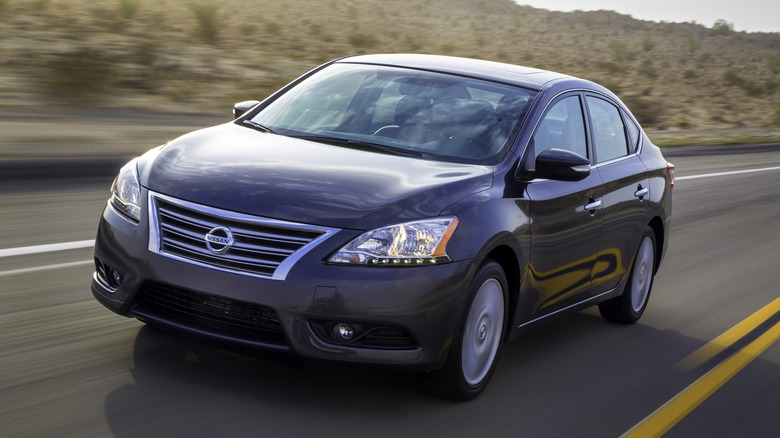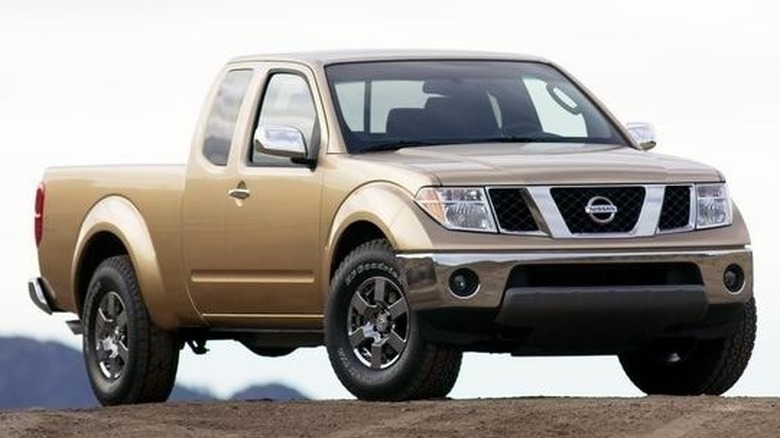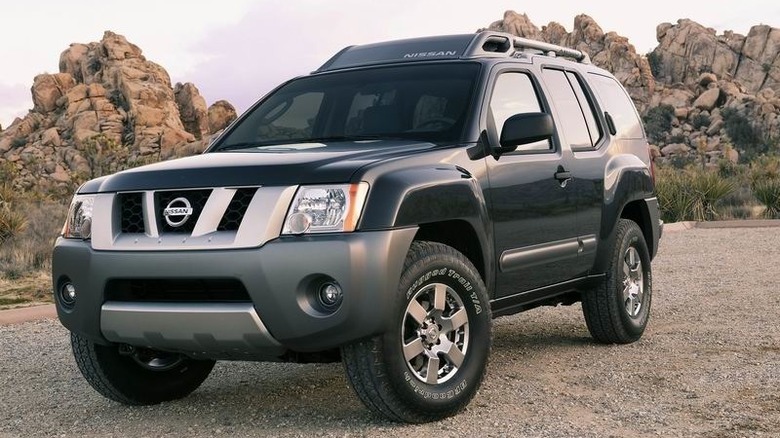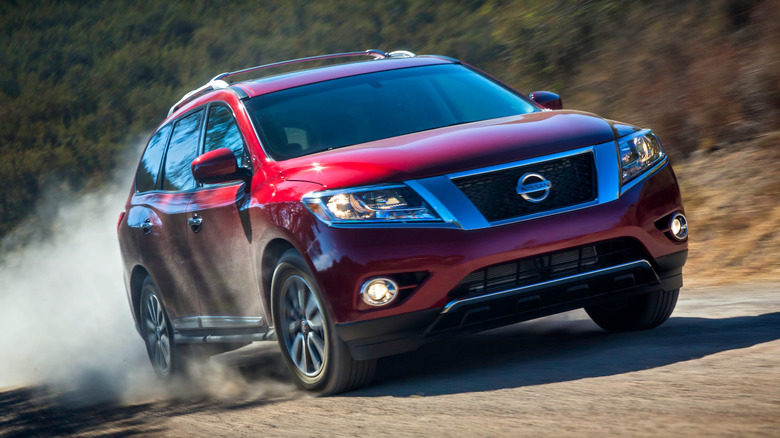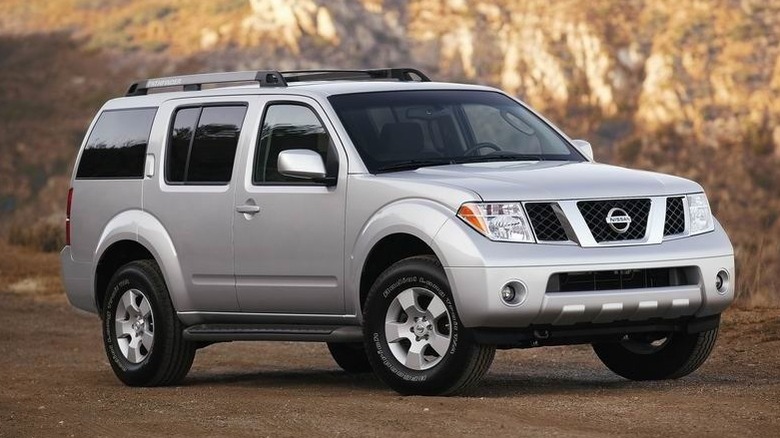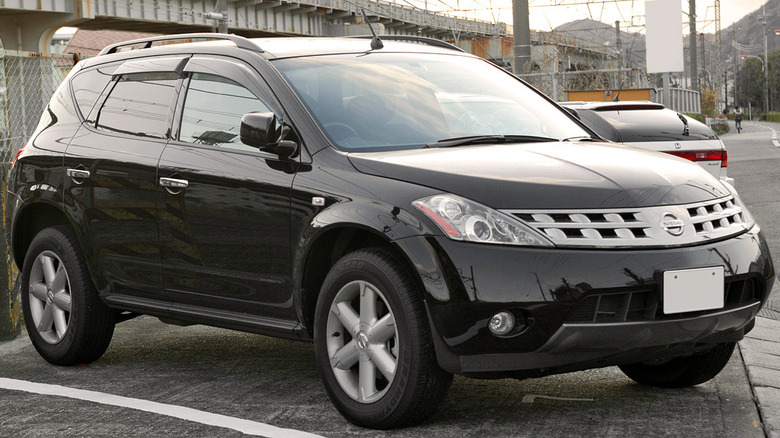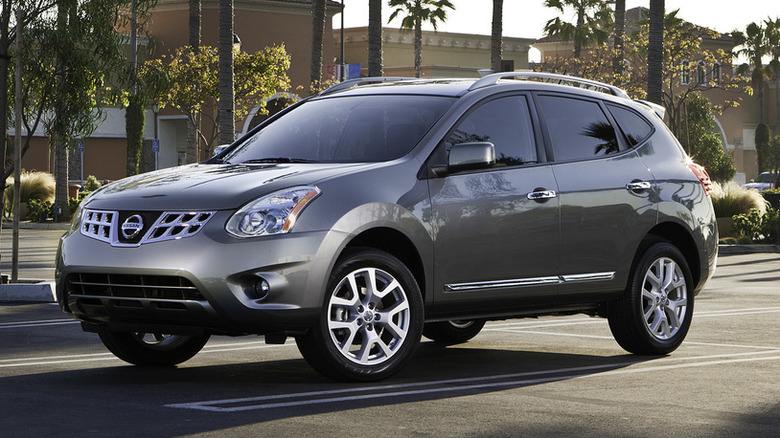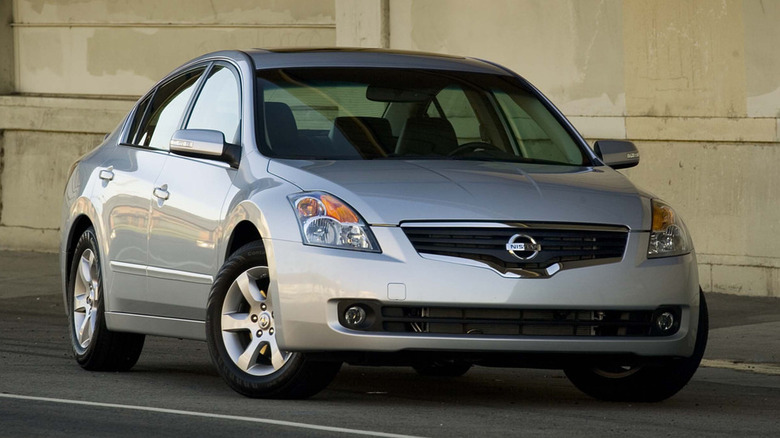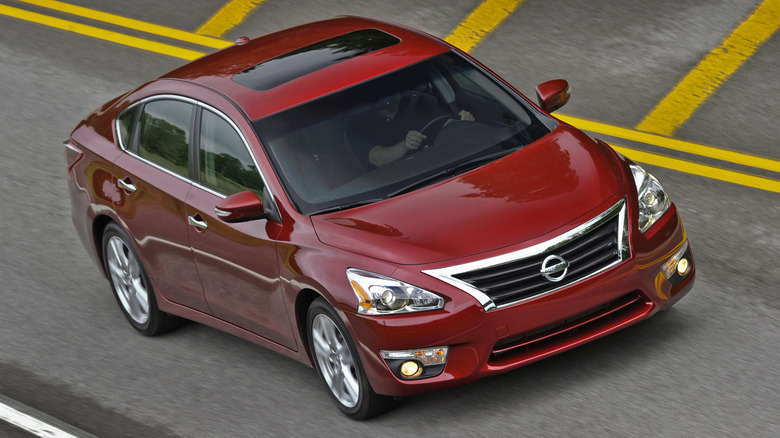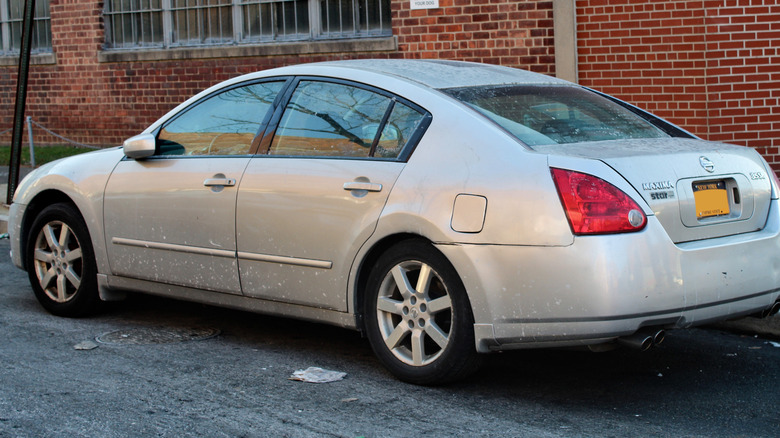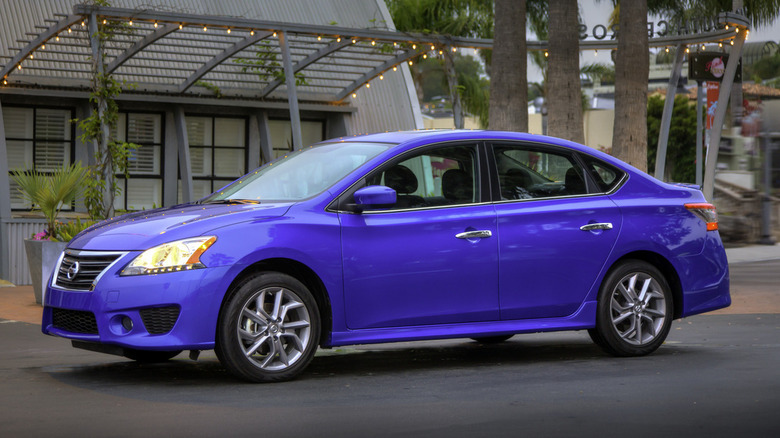10 Used Nissan Models You Should Steer Clear Of At All Costs
Nissan, like many other Asian car manufacturers such as Honda and Toyota, has a decent reputation for making reliable cars. The numbers back this impression up, too: J.D. Power's vehicle dependability survey for 2024 reported 199 problems per 100 cars, which is only slightly above the industry average of 190. However, if you're buying a used Nissan, then you're going back much further than the three years that the J.D. Power survey covers.
As with any other carmaker, Nissan hasn't always got it right with every model. For every classic sports car like the 2002 Silvia, there's a headache-inducing clunker like the 2005 Pathfinder to avoid. Then, there are all the problems with Nissan's Continuous Variable Transmission (CVT) to worry about, too. So what's a potential used Nissan buyer to do? Research, research, and research — which is where our list will come in handy.
We've combed through the U.S. NHTSA database, evaluating user complaints, recalls, and NHTSA investigations to identify 10 used Nissan models you should avoid. Nissan has made too many cars for this to be a definitive list, but it will at least help you eliminate the riskiest Nissans available on the used market.
2005 Nissan Frontier
Nissan debuted the revamped 2005 Frontier at the 2004 Detroit Auto Show, sporting a fresh design language and a ton of upgrades over the outgoing model. Built on the same F-Alpha platform as the full-sized Nissan Titan and available in King Cab and Crew Cab variants, the 2005 Frontier boasted a VQ-series 4.0-liter V6 engine, new off-road tech, and a longer wheelbase for a more comfortable ride. The changes did the trick, with outlets like Motor Trend praising the 2005 Frontier in their reviews.
The good vibes didn't last for long, however. The NHTSA website has complaints stretching back all the way to 2005 involving problematic u-joints and transmission issues, but things started getting really bad for the 2005 frontier in the 2010s. The first reports of a fundamental flaw with the cooling system started surfacing in 2010 and quickly became a deluge. The 2005 Frontier's radiator had a habit of cracking, allowing coolant to leak into the transmission and mix with transmission fluid, eventually wrecking the transmission.
Reports of totally destroyed transmissions started coming in thick and fast, and the problem was severe enough for the North Carolina Consumer Council to officially call for drivers to avoid 2005 to 2010 Frontiers. Despite the widespread nature of the problem, the NHTSA didn't consider it severe enough to launch an official investigation.
The Frontier's VQ engine also had a reputation for a defective timing chain. The problem was serious enough to lead to a class-action lawsuit against Nissan from owners with damaged and wrecked engines.
2005 Nissan Xterra
The 2005 Nissan Xterra is one of the three 2005 Nissans blighted by the leaky radiator issue. The second-generation Xterra debuted after the Frontier and Pathfinder, first appearing at the 2004 New York International Auto Show before coming to dealer forecourts the year after. Like its problematic stablemates, the 2005 Xterra utilized the Nissan F-Alpha platform and improved on the previous model with more power (courtesy of the same VQ-series V6 engine), better off-road abilities, and extra room for passengers and cargo.
Unfortunately, all of these improvements — and the positive reviews they garnered — counted for very little once the radiators in these cars started failing. In what must have felt like an unending nightmare for Nissan and its PR team, reports of wrecked transmissions on 2005 Xterras started coming in within a few years and eventually dominated the complaints section on the NHTSA website starting in 2010. As with the Frontier and Pathfinder, a crack in the radiator allowed coolant to mix with transmission fluid, damaging the transmissions over time and resulting in many owners getting stuck with an immobile Xterra.
Unsurprisingly, the 4.0-liter V6 engine proved just as troublesome on the 2005 Xterra, with many owners experiencing severe engine damage due to its faulty timing chain. The timing chain issues weren't as bad as the radiator and transmission faults, but they were consistent enough that Nissan had to settle a class-action lawsuit by offering affected owners free repairs or a voucher for a new car.
2013 Nissan Pathfinder
Nissan's post-2000 Pathfinders don't necessarily have the best reputations, with the 2005 to 2012 models known for being particularly unreliable cars plagued by the transmission-destroying leaky radiator issue covered elsewhere on our list. When the all-new unibody 2013 Pathfinder launched at the end of 2012, Nissan likely hoped they'd finally put the transmission nightmare behind them. Sadly, that wasn't the case, albeit for entirely different reasons than the older models.
On the positive side, Nissan had indeed fixed the radiator, and owners no longer complained about damage due to coolant mixing with transmission fluid. Unfortunately, the CVT proved very capable of going wrong on its own, coolant or no coolant. Owner complaints started appearing on the NHTSA website within a year, with symptoms including jerking and shuddering, loss of acceleration, missing gears, reluctance to shift, and being stuck in park. Nissan launched a 2013 recall to address an issue with the CVT's oil cooler hose, which could leak and damage the transmission.
Unfortunately, the recall didn't seem to be the clean-cut solution Nissan (and Pathfinder owners) may have hoped for. Some owners have had their CVTs fail a second time, while some whose VINs weren't included in the recall had to deal with a wrecked transmission anyway. Mileage likely plays a prominent role in the latter, with one such occurrence happening on a car with 230,000 miles. All the more reason to avoid a used 2013 Pathfinder, then.
2005 Nissan Pathfinder
The Nissan Pathfinder has been around since 1986, so it's no surprise that a few models over the years fell short of Nissan's usual standards. The 2005 Pathfinder is one of those. Launched alongside the 2005 Frontier at the 2004 Detroit Auto Show, the 2005 Pathfinder shared several of the new features of its pickup stablemate, including the problematic 4.0-liter VQ-series V6 engine that put out 270 horsepower and 291 lb-ft of torque.
If you're guessing that having the same engine meant that the 2005 Pathfinder suffered from the same leaky radiator problem on the Frontier, you'd be right. The majority of the 1,000 complaints the NHTSA has logged involve the engine cooling system and power train, both parts of the car severely affected by the issue prone radiator. Like the Frontier, many Pathfinder owners have had their transmissions fall apart due to coolant and transmission fluid mixing and damaging the transmission. Unsurprisingly, the 2005 Pathfinder is another model that the North Carolina Consumer Council urged owners to avoid, with the recommendation extending to the 2010 model year.
Other common issues with the 2005 Pathfinder include a faulty fuel sender gauge, which prevented the fuel gauge from working correctly. The 2005 Pathfinder also has a suspect engine control module that, when it eventually failed, made the engine easier to stall. Nissan issued a recall for the latter fault in 2010. The V6-equipped 2005 Pathfinder also suffers from the problematic timing chain of its 2005 siblings, adding another point of failure to a problematic vehicle.
2003 Nissan Murano
Nissan introduced the Murano crossover SUV for the 2003 model year at the 2002 New York International Auto Show. The 2003 Murano shared some underpinnings with the 2002 Altima and was notable for a couple of reasons. Firstly, it was Nissan's first-ever crossover SUV. Secondly, and perhaps unfortunately, the 2003 Murano was also the first time Nissan's then-new Xtronic Continuously Variable Transmission came as standard in North America.
While CVTs offer genuine benefits, including better fuel efficiency and a smoother driving experience, Nissan's implementation would quickly prove more trouble than it was worth. Transmission-related grievances make up a good chunk of the nearly 800 owner complaints on the NHTSA website, with most complaints having to do with the car not responding to accelerator input, stalling, and losing power while driving. Invariably, mechanics traced the fault to the transmission, be it the control module or the transmission itself. Some owners even had their transmissions break while driving.
As if that weren't enough, the 2003 Murano also had a dodgy alternator. Nissan's recall notice admitted that a wire breaking inside the alternator could stop it from working and eventually lead to a dead battery. While this should be a simple one-and-done fix, a few owners have claimed that the fault can recur on the replacement alternators. Several owners whose VINs weren't included in the recall also claim that their Muranos have had the same alternator issue.
The 2005 Murano is another model year to avoid, although all first-generation Muranos up to the 2007 model have more complaints than average on the NHTSA website.
[Featured image by Tennen-Gas via Wikimedia Commons | Cropped and scaled | CC BY-SA 3.0]
2013 Nissan Rogue
The 2013 Nissan Rogue doesn't have quite as many complaints logged on the NHTSA website as other models on our list, but that doesn't tell the whole story. Despite appealing less troublesome at a glance, the 2013 Rogue's transmission issues make it another used Nissan best avoided if you want to avoid the risk of headaches down the line. The car shipped with an updated version of Nissan's infamous Xtronic CVT, including extras such as Adaptive Shift Control and a sport mode toggle. Despite the transmission's poor reputation, contemporary reviewers enjoyed the Rogue's CVT. Unfortunately, many owners had a drastically different experience.
As with many CVT-equipped Nissan vehicles, 2013 Rogue owners have had to deal with a range of transmission-related issues, as shown on the NHTSA database. Some owners reported that their Rogues would lose power and fail to accelerate during long drives or when going uphill. Nissan attributed this to faulty logic in the CVT's fluid temperature protection circuit, which caused the transmission to overheat. The company recommended installing an oil cooler to compensate for the issue but stopped short of a recall or a Voluntary Service Campaign.
All the other CVT-related issues common to Nissans, including destroyed transmissions and damaged transfer cases, are also present and accounted for. Unfortunately, while the 2014 to 2018 Rogues received extended CVT warranties — increasing the odds of buying one with a serviced transmission — Nissan doesn't seem to have done the same for the 2013 model.
2009 Nissan Altima
Nissan released the fourth generation of its mid-sized Altima sedan in 2007, after first showing it off at the 2006 New York International Auto Show. The fourth generation boasted many upgrades over the previous generation, including an all-new platform and a CVT. Reviewers liked the new Altima, and the fourth-generation Altima would set sales records for the next few years. Things were looking good — right up to 2009.
While Nissan didn't make any significant changes for 2009, something about the car's Electronic Steering Column Lock (ESCL) went wrong this year. The ESCL on the 2009 (and 2010) Altimas is known for going bad and not detecting the key fob. When this happens, the steering locks up as a security measure, preventing the owner from starting the car. This is a widespread problem for the 2009 Altima, with more than half of the complaints the NHTSA has logged involving the steering column in one way or another.
To its credit, Nissan extended the warranty on the ESCL to six years and unlimited miles (up from three years and 36,000 miles). Nissan took another stab at resolving the issue in 2017, launching a Voluntary Service Campaign until 2020 to fix the ESCL issue. Unfortunately, since neither of these were recalls, it's possible many owners missed both chances to get their steering columns replaced — which passes the issue on to you.
2013 Nissan Altima
Nissan showed off the fifth-generation Nissan Altima at the 2012 New York International Auto Show before launching it in 2013 with a bullish press campaign highlighting its all-new design and features. Between additions and improvements such as a lighter body, a more efficient 2.5-liter engine, and the new and improved Xtronic CVT, the 2013 Altima promised quite a lot, at least for a mid-sized sedan. Reviewers appreciated the changes and generally enjoyed the 2013 Altima, CVT and all.
Like other CVT-equipped 2013 Nissans, the NHTSA website hosts a wide range of transmission complaints related to the 2013 Altima. These include stalling, jerking and shuddering, missing or slipping gears — essentially, the same problems you've likely heard about when anyone talks about Nissan's CVT transmissions. Unlike other models, however, the 2013 Altima's CVT-related woes are only the tip of the iceberg.
Other issues that 2013 Altima owners have encountered range from outright show-stoppers to those that, while not quite as bad, are certainly still unpleasant. These include issues with a faulty brake pedal solenoid that stops the transmission from shifting out of park, the passenger-side airbag detection circuitry failing, and broken key fobs preventing the car from starting or killing power while in motion. Less-hazardous faults include delaminating headlight assemblies, which negatively impact visibility regardless of the bulbs installed. There's also issues with the air conditioner's compressor, which can fail and lead to the air conditioner blowing out stale air.
2004 Nissan Maxima
Nissan's CVT transmissions may get a bad rap, but Nissan's transmission woes in the 2000s extend well beyond their CVTs. Even some of their conventional automatic transmissions have proven troublesome and unreliable, such as the unit installed in the 2004 Nissan Maxima. The sixth-generation Maxima debuted at the 2003 Detroit Auto Show with all-new styling, updated trim options, and a new five-speed automatic gearbox.
While it would be a stretch to blame the latter entirely for the 2004 Maxima's woes, it's impossible to avoid the fact that a significant proportion of the 1,400 complaints on the NHTSA website for the 2004 Maxima involve the powertrain. More specifically, the transmission. Owners complain of slipping and missing gears, jerky acceleration, hard up- and downshifts, delayed acceleration, and total transmission failure. The transmission seems to fail regularly, too, with several owners stating that their rebuilt transmissions eventually failed similarly to the originals.
Unfortunately, the NHTSA website doesn't differentiate between four- and five-speed models. Still, we noticed that owners who mentioned specific gears in their complaints would more often than not mention the presence of (or an issue with) the fifth gear. The 2004 Maxima also has some potential structural issues, with rusted-out front subframes and floorboards causing Missouri owners to file a class-action lawsuit in 2022. This led to Nissan launching a Voluntary Service Campaign in 2023 to inspect and fix these parts of the 2004 Maxima.
[Featured image by Kevauto via Wikimedia Commons | Cropped and scaled | CC BY-SA 4.0]
2013 Nissan Sentra
Nissan's Sentra has been around for a long time, with the first-ever Sentra debuting all the way back in 1982. It's been a staple of Nissan's lineup ever since. While recent Sentras have been well-received and very popular — the 2022 Sentra was Nissan's best-selling sedan — things haven't always been rosy for Nissan's perennial small sedan. Case in point, the 2013 Nissan Sentra.
Overall, 2013 wasn't a great year for Nissan, and the Sentra was no exception. Similarly to many of its stablemates, Nissan introduced the Xtronic CVT for the 2013 model year, bringing with it improved fuel economy compared to previous CVTs. As you may expect, though, the upsides of the new CVT were quickly outweighed by all the recurring problems this particular generation of CVTs had: missing gears, inability to shift, loss of acceleration, and, in some cases, total failure.
Invariably, the solution was an expensive new transmission. Sadly, even a new transmission doesn't guarantee a trouble-free future, as some complaints the NHTSA received allege consecutive CVT failures, turning 2013 Sentras into a money pit for their owners. Beyond that, it appears that the 2013 Sentra's brakes haven't fared too well, either, and many owners have reported malfunctioning brakes. The most common symptom is excessively long pedal travel linked to a cracked or defective master cylinder. There's also the all-too-common (and recalled) issue with the passenger airbag sensor not detecting an occupant and thus not deploying the airbag in a crash.
Our selection methodology
We referred to the NHTSA's website to build this list of used Nissans to avoid, focusing primarily on the number of owner complaints for each model, which is generally a good indicator of problematic cars. However, we also considered the types of complaints, as some problems — such as transmission and engine problems — are much more severe than minor or easily fixed issues such as failed power windows or low-quality factory paint, for example.
That said, manufacturer recalls also played a part in our selection, as they're another valuable indicator of troubled cars that you're better off avoiding. Considering that recalls involve safety problems that have to be fixed, buying a model with a huge list of recalls is a risk we don't think anyone should take.
Our primary concern with recalls is the possibility that the previous owner failed to send their vehicle in for repair. Still, even if they did, we've seen enough complaints about recurring failures after recalls to know that even a car that was dutifully sent in every time may not be problem-free.
